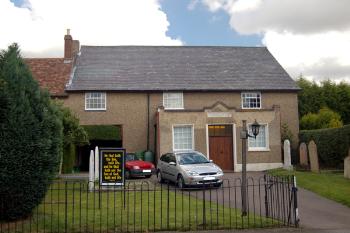
Southill Strict Baptist Chapel about 1920 [Z1306/106]
The Strict Baptist church in Southill began life as an Independent church in 1693 when it seems to have been known as a "church in and around Bedford" almost as though setting itself up as competition to the Independent church in Bedford which had been led by John Bunyan until his death in 1688.
Bedfordshire & Luton Archives & Records Service has, in the searchroom library, a transcription of the original Church Book which extends from 1693 to 1851 [130Southill ]. It begins: "It appears from the subsequent account, which I suppose was written by Mr.Killingworth, that the Church of Christ which now assembles at Southill, was first formed in the year 1693. Several Ministers and Messengers From the Churches at Rowell, Wellingborough, Kimbolton, Needingworth and Hartford, attended, on the 23rs of June in the above year when it was formed and in November following Mr.Killingworth was chosen Pastor".
A list of deeds of the meeting shows that in 1714 Nathaniel Costing of Clapham, yeoman conveyed a messuage and half a pole of ground "in which there is a well" in Southill in occupation of Richard Huggins and a house "now used as a Meeting House near the same being late the house of John Langley in Southill" for £30 to trustees "for and as a public meeting house for them and their friends the particular Congregation or Christian Society now meeting there, and for all other persons to resort openly and freely unto for the Worship of God, to hear the Word of God preached, and for other exercises of Religion to be performed by the Preacher or Teacher appointed or imployed". The trustees at his date were William Beaumont of Hill, Old Warden, yeoman; Joseph Cotton of Chicksands, yeoman; William Cooper of Holme, Biggleswade, yeoman; Thomas Brett of Kingswood [Hertfordshire], yeoman; William Beaumont of Biggleswade; William Giddings of Shefford, wheeler; Thomas Hawkins junior of Southill, butcher, Thomas Wright of Southill, yeoman; Thomas Crouch of Clifton, yeoman. Only two of nine, therefore, were Southill men [CRT170/3/28].
Two deeds appointing new trustees followed, in 1737 and 1765 before an appointment of 1803 which refers to Baptists for the first time. In this transfer is the phrase: "and that premises had come to be used by a Society of Protestant Dissenters commonly or usually called Baptists for exercise of religious worship". At this date the house previously occupied by Richard Huggins was occupied by Ann Gambey [CRT170/3/28].
Two years later Samuel Whitbread conveyed the trustees a piece of land of 24 perches on the northern boundary of the chapel site "to allow the Trustees to enlarge the Meeting House and to make the approach more convenient". In this deed the meeting house is that of "the Society of Protestant Dissenters there called Independent Baptists". What seems to have happened is that the old meeting house and the dwelling of Richard Huggins, later Ann Gambey, were both pulled down just before Samuel Whitbread's conveyance (which mentions "a new meeting house has been lately erected"). A transfer of trustees of 1847 notes "that the dwelling house and meeting house were long ago pulled down and another dwelling house and meeting house and schoolroom erected on the site" [CRT170/3/28].

Strict Baptist chapel Southill July 2007
On Sunday 30th March 1851 a census of all churches, chapels and preaching-houses of every denomination was undertaken in England and Wales. The local results were published by Bedfordshire Historical Records Society in 1975 as Volume 54, edited by D.W.Bushby. The return for Southill Particular Baptists Meeting, made by John Warburton, the minister gives seating accommodation as 480 and standing room for 50. Numbers were high - 300 in the morning, 500 in the afternoon (obviously a squeeze) and 150 in the evening. There were, in addition, a hundred Sunday Scholars
A transfer to new trustees of 1887 refers to the meeting house being "used solely as a place for the public Worship of God according to the usages of Protestant Dissenters of the Denomination called Strict Baptists" The deed goes on to note that the accompanying dwelling was used as the residence of the minister [CRT170/3/28]